
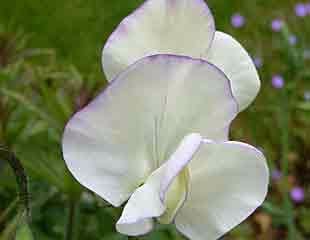
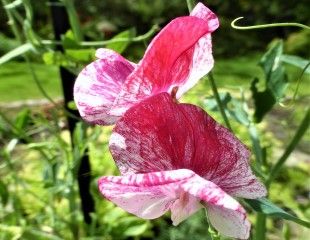
How to grow sweet peas
Sweet peas are a summer flowering annual.
This means that they germinate, grow, flower, set seed and die all in one year and have to be re-grown each year. Sweet peas are long flowering and provide colour, scent and flowers to pick for months. Sweet peas are not difficult to grow, but they need regular attention throughout the summer to dead head, take off the tendrils, train and tie them in. For this reason, they are a red wheelbarrow plant.
The good thing about sweet peas is the more you pick, the more you get. You can remove every bloom from a set of Sweet peas and within days they will be back, so keep picking.
Sweet peas are best planted in full sun in rich, moisture retentive soil.
Removing the spent flowers prevents the plant from making seed, which keeps it producing more flowers and prolongs the flowering season. Sweet peas require extra attention if you want straight stems. It is necessary to remove the tendrils regularly, see more below and a video.
If you encounter problems growing Sweet Peas, the most common problem is powdery mildew, a fungus which leaves white powder on the leaves. This fungus is much more likely to attack the plant if it is dry, which is why it is important to water sweet peas, especially during dry periods and to have plenty of organic matter in the soil to retain water. There is a Sunday gardener Video How to plant and grow sweet peas.
Sweet Peas are a popular choice for planting in containers. All plants grown in containers dry out more quickly, which makes Sweet Peas prone to attack by mildew. If you are growing Sweet peas in containers, consider adding water retaining gel and a good mulch to retain moisture. It also follows they will require regular watering, especially during dry spells.
If growing annual Sweet Peas is too much trouble, check out the Everlasting Sweet Pea which has the same lovely delicate flowers, albeit not scented, but as a perennial will return reliably and flower year after year.
Sweet pea videos
How to cut back sweet peas to get more flowers
Removing tendrils from sweet peas

How Hardy are Sweet Peas
Sweet peas are a hardy annual, which means they will tolerate cold, even a light frost below if freezing. They are tougher than they look and will take a regular frost down to around -4. It is only if a hard frost or prolonged period of low temperatures is forecast, that Sweet Peas require protection, such as with a fleece.
As Sweet peas are hardy, do not leave planting until too late. Sweet Pea can be planted during from March onwards. They are best grown with a support, such as a trellis or an obelisk, and tie the sweet peas in.
If you want straight stems, and sweet peas which grow up the frame and not a tangled bunch, it is necessary to remove the tendrils and not to let these grow unchecked. Why? See how to get straight stems on sweet peas.
Keep picking sweet peas, don't let the seed head form. If you are not sure about seed pods, check out the image the seed pod is ringed in red. Remove all seed heads as they form and the sweet pea will reward you with more and more flowers.
How to Grow Sweet Peas
How to remove tendrils from Sweet Peas
How to Grow Sweet Peas from Seed
Sweet Peas are easy to germinate and buying seed gives you a wider choice in terms of fragrance and colour, although more time-consuming. Many of the garden centres sell Sweet Peas seeds in mixed colours, which is good, but it is also nice to have single colours to contrast and complement other summer flowering plants. Sweet peas can be germinated under glass in either spring or autumn, the latter will require protection over the winter.
In 2019, for the first time, I bought Sweet peas from a garden centre as opposed to choosing my own varieties and growing from seed. They were a disappointment. The bought Sweet peas did not have such lovely blooms; the stems were shorter, and I did not think the fragrance was as good.
There is a perennial sweet pea called Lathyrus latifolius which blooms every year and the flowers look very similar to the annual variety. The positive is that this variety of sweet pea is perennial, but the downside not scented.
Sweet Pea containers
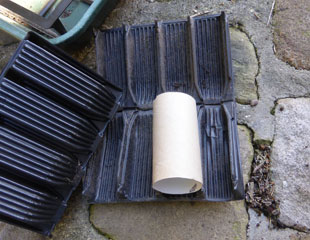
Sweet Peas are quick and easy to germinate, a little heat will speed up germination, but it is not essential. You can germinate Sweet Peas on a warm windowsill, conservatory or using heated propagator to get a temperature of about 15C/ 59F. Autumn sown Sweet Peas will germinate in a greenhouse/lean to with no additional heat. When growing Sweet Peas from seed, the choice of container is important. Sweet Peas, like many legumes including peas and beans, have long roots, which means it's important to plant them into a deep container, and not a regular pot to give a long root run.
You can use either root trainers sold by all garden centres, or cheaper and just as easy toilet roll holders, they are both illustrated in the image. If you are sowing Autumn sweet peas to over winter, they are best in root trainers as there is a risk the cardboard tubes will get damp, disintegrate and /or encourage mould over the winter. Equally, the cardboard tubes are fine for a Spring sowing of sweet peas. Just take care when watering, not to soak the tube.
When and how to sow sweet peas
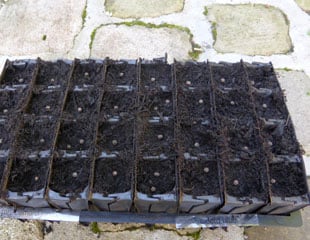
Put two/three seeds into the container, placing the seed near the top to give plenty of room for the roots to grow down. Sprinkle with a light covering of compost, spray with water so the compost is moist, but not too wet and place in a warm place. It's essential for germination to cover with a lid or clear polythene. Germination should occur within a few days and as soon as the sweet pea seedling is a few centimetres above the soil, remove from the propagator or take off the cover to prevent the seedling from getting too warm, which will make it sappy and leggy. Only use the heat to speed up germination. Sweet peas can be successfully germinated in the Autumn in a warm conservatory and then moved into an unheated greenhouse for the winter. Provided the sweet peas are protected from frost under glass, they will overwinter and produce sturdy plants for the Spring. Autumn sown sweet peas tend to flower earlier in the year, and by sowing both in Autumn and Spring the flowering season can be extended.
Take out growing point
Whether you sow in Autumn or Spring, with young sweet peas at the seedling stage, if you pinch out the growing point, it will make the seedling produce throw out shoots and the additional shoots will bear flowers.
In the video I take a look at caring for Sweet peas and in particular, how to take out the growing point. The video explains how to cut back the growth point to make the sweet pea throw out more shoots, which results in more flowering stems in the summer.
The images below:
The first image shows the young sweet peas with several early leaves already formed
Secateurs to show where to remove the growing point.
The centre image shows the entire tray of seedlings in which every seedling has the top growing point removed.
The third image taken about 10-14 days later after and instead of just the single stem, there is now a double shoot.
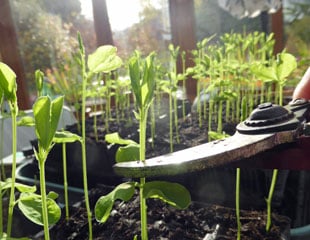
Sweet pea cutting back growth point
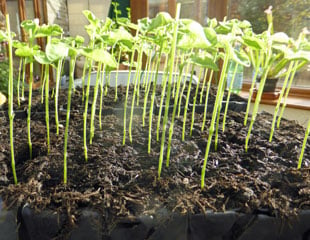
Sweet pea all growth points removed
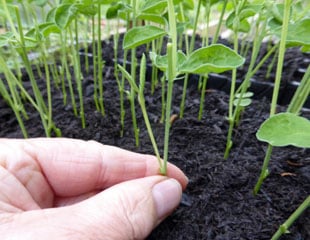
Sweet pea after cutting back growth point has new shoot
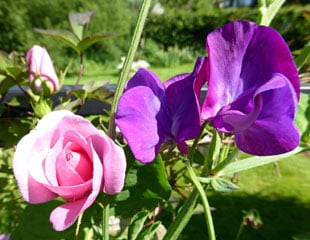

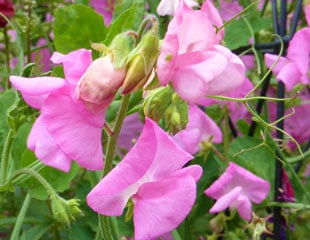

Red Wheelbarrow means that Sweet Peas are time-consuming to grow.
Once planted, if the summer is dry, Sweet Peas need regular watering. Being dry exacerbates the likelihood that they develop mildew.
To keep the flowering, it is necessary to remove all the seed heads.
To keep them straight and looking good, it is also necessary to remove all tendrils.
Growing around 50 or so plants for a good display, this takes up to an hour, a couple of times a week during the high summer, which makes for high maintenance.

